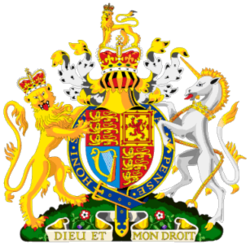List of British monarchs
|
|
This is a list of British monarchs, that is, the monarchs on the thrones of some of the various kingdoms that have existed on, or incorporated, the island of Great Britain, namely:
- England (united with Wales from 1536) up to 1707;
- Scotland up to 1707;
- The Kingdom of Great Britain (after England & Scotland united in 1707);
- The United Kingdom of Great Britain and Ireland (after Great Britain and Ireland united in 1801)
- The United Kingdom of Great Britain and Northern Ireland (The UK after the Irish Free State was formed and became a separate nation in the 1920s).
Since 1559 English monarchs have had the title Supreme Governor of the Church of England.
In 1328, on the death of the French king, Charles IV, Edward III (nephew of Charles IV) claimed the French throne. British monarchs then styled themselves "King/Queen of France" until the Act of Union, which led to the creation of the United Kingdom in 1801. By then France had been a republic for ten years. See: English Kings of France
Note that the numbering of English monarchs starts afresh after 1066 (although this effects only the Edwards).
To see the rulers of the small kingdoms which existed before the formation of England, Scotland or Wales, see:
- Mythical British Kings
- List of rulers of Wales
- Kings of the Picts
- Kings of Dalriada
- Kings of Strathclyde
- Kings of the Isle of Man and the Isles
- Kings of the Isle of Man
- Kings of East Anglia
- Kings of Essex
- Kings of Kent
- Kings of Sussex
- Kings of Wessex
- Kings of Mercia
- Kings of Northumbria
See also: Bretwalda
| Contents |
Complications over Title and Style
James_I_of_England.JPG
Royal titles are complicated because in some cases names of kingdoms are used that did not officially come into existence until later, or came into existence earlier without immediate adoption of the royal title.
- For example, in October 1604, one year after James VI of Scotland had become King of England, he decreed that the Royal Title would use the term Great Brittaine to refer to the "one Imperiall Crowne" made up of England and Scotland. However using that title is problematic because the 'state' of Great Britain was not created until the Act of Union 1707. Nor was the united crown generally referred to as 'imperial'. Furthermore, monarchs continued to use ordinals attached to the two previous kingdoms, for instance James VII/II. To avoid confusion, historians in general thus refer to all monarchs up to 1707 as monarchs of England and Scotland (so explaining their two ordinals where they existed), with the monarch's title at all times accurately following the official name or names of the state or states they reigned over where it differed from the official royal title. (Hence though many English and British monarchs claimed France as part of their official title, that had no reality in substance, so it isn't used.) After the Union, the ordinal has either been the English number, or the greater of the two numbers - the results have been the same and there is no formal rule.
- In different documents, the terms Kingdom of Great Britain and United Kingdom of Great Britain feature, even documents as official as the Act of Union 1707. Most historians presume the United was meant to be descriptive, indicating a union as a form of unity by marriage rather than coercion. For clarity and because the United is far more strongly associated with the later name United Kingdom of Great Britain and Ireland produced in the Act of Union 1800, the 1707 Kingdom is generally referred to as the Kingdom of Great Britain.
- Similarly, though the Irish Free State ceased to be part of the United Kingdom of Great Britain and Ireland in 1922, neither the full name of the United Kingdom nor the royal title were changed until the Royal and Parliamentary Titles Act 1927. In this instance historians generally retrospectively date the coming into being of the modern United Kingdom to December 1922, even though in this case the formal change did not occur for another five years.
The list of monarchs below cannot be exhaustive. Succession to the many thrones often did not pass smoothly from parent to child; lack of heirs, civil wars, murders and invasions affected the inheritance in ways that a simple list does not show. The relationships that formed the basis for claims to throne are noted where we know them, and the dates of reign indicated.
Monarchs
| |||||||||||||||||||||||||||||||||||||||||||||||||||||||||||||||||||||||||||||||||||||||||||||||||||||||||||||||||||||||||||||||||||||||||||||||||||||||||||||||||||||||||||||||||||||||||||||||||||||||||||||||||||||||||||||||||||||||||||||||||||||||||||||||||||||||||||||||||||||||||||||||||||||||||||||||||||||||||||||||||||||||||||||||||||||||||||||||||||||||||||||||||||||||||||||||||||||||||||||||||||||||||||||||||||||||||||||||||||||||||||||||||||||||||||||||
*Lady Jane Grey ruled for 9 days in 1553 but was deposed by Mary I.
Mnemonics
A useful rhyme for memorising the names of the English and UK monarchs since the Norman Conquest in chronological order as well as a version was featured in part in the movie King Ralph:
| Mnemonics | Popular variation |
|---|---|
|
|
See also
- Other lists of incumbents
- UK topics
- British monarchs family tree
- English monarchs family tree
- Scottish monarchs family tree
- Style of the British Sovereign
- List of succession to the British throne
- Wikipedia:WikiProject Monarchs
- Chinese history mnemonics.
- Category:British queen consorts
- Category:English queen consorts
References
- The official website of the British Monarchy (http://www.royal.gov.uk/output/Page5.asp)
- Britannia.com (http://www.britannia.com/history/h6f.html)bg:Крал на Обединено кралство Великобритания и Северна Ирландия
cy:Brenhinoedd y Deyrnas Unedig de:Liste der Herrscher Englands eo:Listo de britaj reĝoj fi:Englannin kuningas fr:Monarques de Grande-Bretagne he:מלכי בריטניה it:Elenco di monarchi britannici ja:イギリス君主一覧 ko:영국의 군주 la:Index Regum Britanniae li:Keuninge van Ingeland, Sjotland, Groet-Brittannië en 't Vereineg Keuninkriek nl:Lijst van Engelse koningen no:Liste over britiske monarker pl:Władcy brytyjscy pt:Lista de reis britânicos sv:Englands regenter zh:英国君主列表


